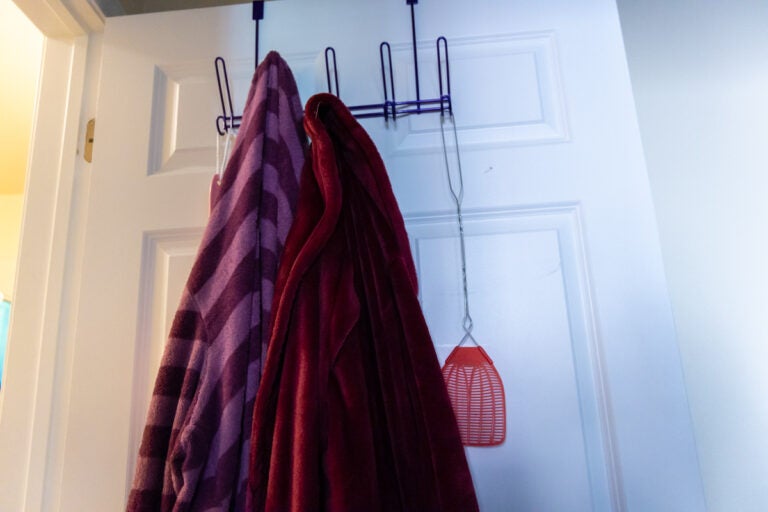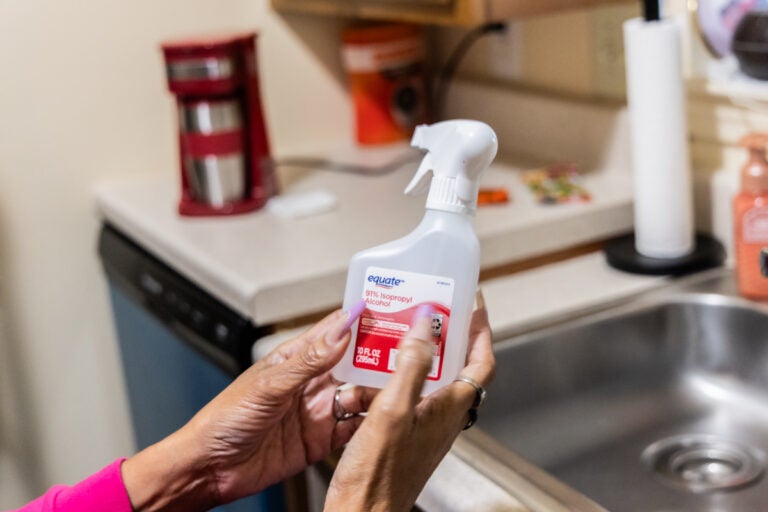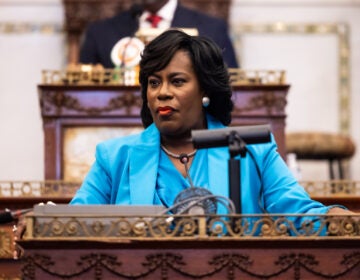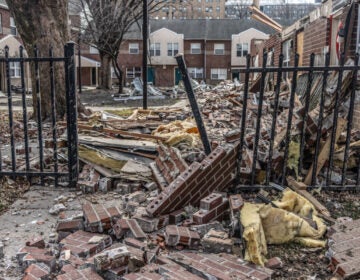Who will benefit from Philly’s $2 billion housing plan? Not the most vulnerable, advocates say
Critics argue that Mayor Parker’s H.O.M.E. initiative doesn’t focus enough on the city’s lowest-income renters and homeowners, including older adults.
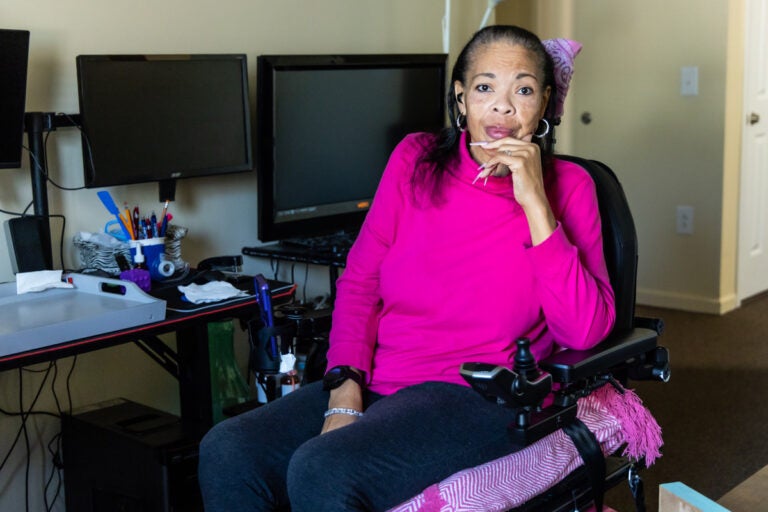
Lori Peterson in the apartment she’s rented for a year in North Philadelphia. (Kimberly Paynter/WHYY)
Have a question about Philly’s neighborhoods or the systems that shape them? PlanPhilly reporters want to hear from you! Ask us a question or send us a story idea you think we should cover.
Mayor Cherelle Parker’s housing plan has always raised a simple but difficult question: Who should benefit from this unprecedented investment?
Her administration is adamant about the answer: everyone who needs help.
“I am committed to working with our legislative body, this City Council, to put people on a path to self-sufficiency and will not engage in policy making that breeds class contempt by pitting the have-nots against those who have just a little,” Parker said during a special address in February.
Some housing advocates have never quite agreed with that philosophy. While they applaud the mayor for making housing a priority, they don’t think her $2 billion plan, dubbed the Housing Opportunities Made Easy, or H.O.M.E., initiative, will help the city’s most vulnerable and cost-burdened residents. And they’re pushing for change in the plan as lawmakers move towards approving the initiative’s first phase, which calls for about $195 million in annual spending.
Under the current proposal, only one program, a $3.8 million homelessness prevention initiative, is exclusively for households earning at or below 30% of the area median income. For a family of four, that translates to $35,800 a year.
And yet more than 200,000 Philadelphians live at that income level, according to research published this year by the Housing Initiative at Penn (HIP). That translates to 1 in 3 renters and 1 in 5 homeowners in the city.
“In the midst of a housing crisis, when we are already seeing major cuts from the federal government, we want to see our mayor and City Council step up to protect those of us most at risk of being pushed out of our homes and neighborhoods,” said David Evans, leader of Reclaim Philadelphia’s Homes for All Caucus.
Older adults are the most at-risk population
The need for affordable housing is especially dire for low-income older adults, many of whom are living on a fixed income. That’s led some advocates to question why the plan’s first proposed budget, the subject of a public hearing on Wednesday, doesn’t include any dedicated funding for homes catering to residents in that demographic, particularly for new rentals.
Nearly 24,000 households in Philadelphia where all tenants are 65 or older are considered rent-burdened, meaning more than 30% of their income goes towards gross rent, according to Census data crunched by HIP. Gross rent includes the base rent and other expenses like utilities.
There are a total of 12,132 units of federally subsidized rental properties in the city that are targeted toward older adults and have active affordability requirements.
“We did what we needed to do when we worked. Now, what do we do? We have nowhere to go. That’s your job to give us a place to go. Help us,” said Lori Peterson, 64, a member of OnePA Renters United.
It took Peterson, a retired school crossing guard, roughly seven years to find an affordable unit that was safe and habitable. During that stretch, she said she looked at a minimum of 50 properties, including some that were outside of Philadelphia. Most had yearslong waiting lists. Others had age requirements she didn’t meet.
In the interim, Peterson rented a one-bedroom apartment at a West Oak Lane building owned by Odin Properties, one of the city’s largest landlords. And almost immediately, she started contending with a cockroach infestation so bad that she would routinely find insects crawling across her body and her belongings.
But like many low-income seniors, Peterson couldn’t afford to leave, forcing her to live with substandard conditions while she searched for a better place.
“I’ve now been diagnosed with PTSD,” Peterson said, referring to post-traumatic stress disorder. “No one, and I mean no one, should have to go through the ordeal that I went through. They just did not take the time to care about anybody living in that building.”
About a year ago, she moved into a handicap accessible unit in a North Philadelphia building that is roach-free. She said she feels blessed but that the stress of her search for a habitable apartment still lingers.
“Nobody should have to do that,” she said.
The mayor’s plan is rooted in creating and preserving 30,000 units of housing. And it includes funding for programs the administration hopes will benefit seniors.
For example, the latest iteration of the plan’s first budget calls for almost $54 million for creating and preserving affordable housing. Those dollars will provide what’s known as “gap” funding for developers to build and acquire properties, as well as renovate and preserve them.
“We’re just prepared to respond to what folks need the most. And if in fact that’s senior housing, we’ll find the way to make sure that we support that. But I think that the key here is to provide the subsidy needed,” said Jessie Lawrence, director of the city’s Department of Planning and Development.
To Lawrence, that flexibility is critical for a multifaceted, multiyear plan.
“That’s why we have erred on the side of comprehensiveness, as opposed to maybe target populations,” he said.
High construction costs create a limited supply
Any funding from the H.O.M.E. initiative for affordable senior housing would be in addition to the grant dollars the city has long provided through its Division of Housing and Community Development to create affordable housing.
That money is typically part of a complex capital stack undergirded by low-income housing tax credits, the country’s main mechanism for the production of affordable rental housing. Typically administered by state housing agencies, the highly competitive subsidy is used by housing authorities, as well as private and nonprofit developers, to offset construction costs.
Similar to most deeply affordable housing projects in Pennsylvania, developments dedicated to low-income seniors generally cannot be completed without public subsidies, in large part because of the capital expenses and the tight profit margins inherent to this market segment.
For that reason, experts say it’s difficult to produce affordable senior housing at the scale needed to meet the demand — even if there was dedicated funding from the mayor’s plan.
“Clearly, the city can’t be the source of funding to address the shortage of housing we need for our seniors, or young people or anybody else,” said Joseph Duffey, president and CEO of NewCourtland, which operates nearly 600 units of affordable housing in Philadelphia, primarily for seniors. “But the city’s initiatives can create hope in the community and attract other capital back into the community.”
Affordable senior housing projects generally do not exceed 50 units. And even getting those built takes time, especially if a developer isn’t awarded tax credits the first time they apply. It is not unusual for a project to take two or three years to complete.
From there, renters must often wait years for a unit to become available, which generally happens when a tenant dies. As a result, low-income seniors in Philadelphia often find themselves with substandard housing because the options that fit their budget are so limited.
Others may opt to stay with relatives in the city or leave the area altogether. A smaller percentage end up in homeless shelters or living on the street.
Adam Weintraub-Barth, director of housing justice at the SeniorLAW Center, said that reality highlights the need for the city to invest more in the production of affordable senior housing, even if it can’t put a dent in the demand.
“Our concern is that if they’re only getting a small piece of this 30,000-unit pie, it’s really going to make the smallest ripple in the pond,” Weintraub-Barth said. “It’ll change a few lives, but not nearly as many as it could and that we hope it will.”
Calls for change
The H.O.M.E. initiative is backed by $800 million in bonds.
The administration hopes to borrow the first chunk of that total before the year ends. But that can’t happen until Council approves a resolution detailing the first annual budget for the plan, Lawrence said.
And the vote won’t happen until lawmakers agree on the final form of the measure, meaning it’s possible the measure will be amended.
City Councilmember Jamie Gauthier, who leads the body’s housing committee, has said she will push to help households earning less than $30,000 a year — “families who are just one maintenance emergency or rent hike away from homelessness.”
She’s also focused on low-income seniors. Gauthier, in a statement, said she wants to see the Basic Systems Repair Program and Adaptive Modifications Program fully funded so that seniors aren’t waiting “months, if not years, for help they are entitled to.”
The proposed annual budget calls for about $35 million for the repair program, which provides free home repairs to qualified residents, and about $9 million for the modifications program, which provides home adaptation projects, at no cost, to permanently disabled renters and homeowners.
“We also need to increase the H.O.M.E. Plan’s investment in affordable housing creation and preservation,” she said. “By bringing more senior affordable housing apartments online, we give our elders the chance to stay rooted in their communities, even if living in an entire house becomes too expensive or difficult for them.”
Those investments may come up during Wednesday’s hearing. And that may be the only opportunity for tenants and homeowners to have their voices heard on the proposed budget before Council votes.

Subscribe to PlanPhilly
WHYY is your source for fact-based, in-depth journalism and information. As a nonprofit organization, we rely on financial support from readers like you. Please give today.





